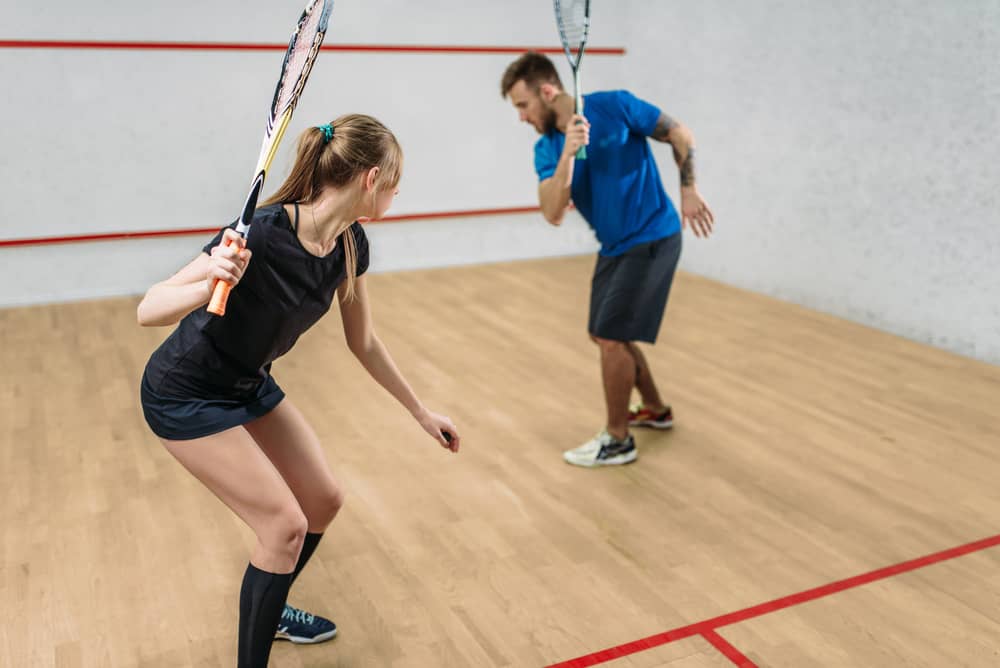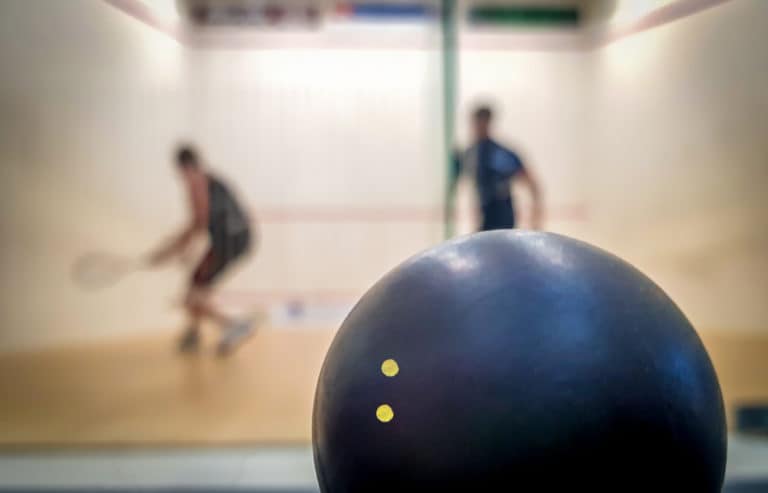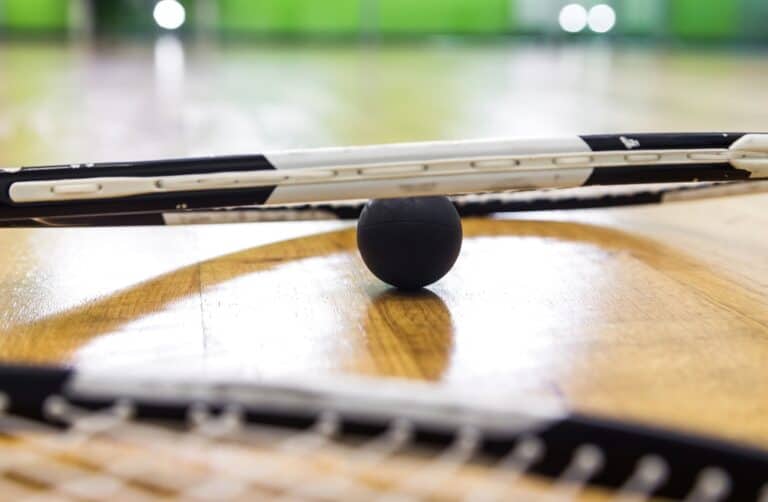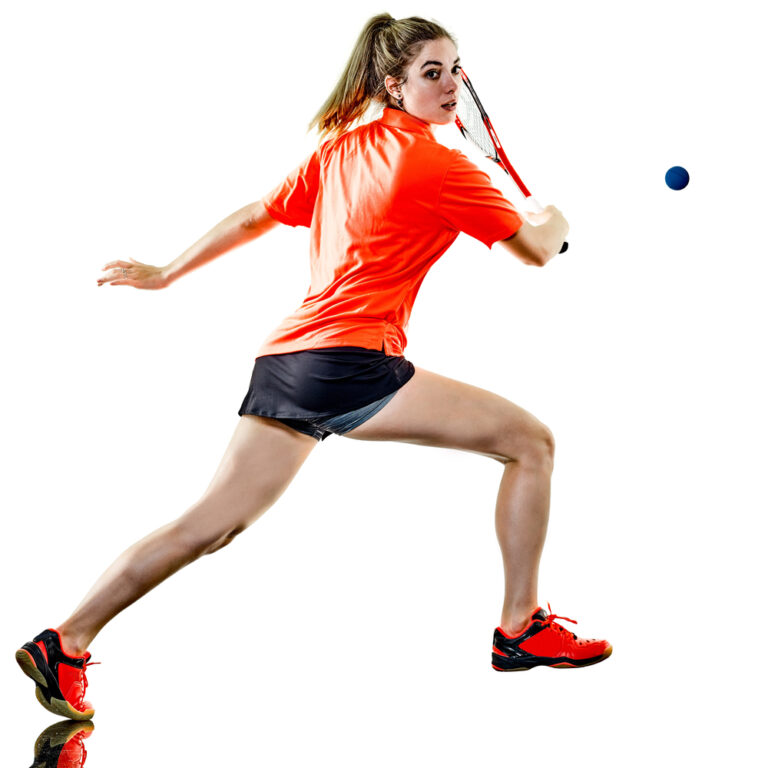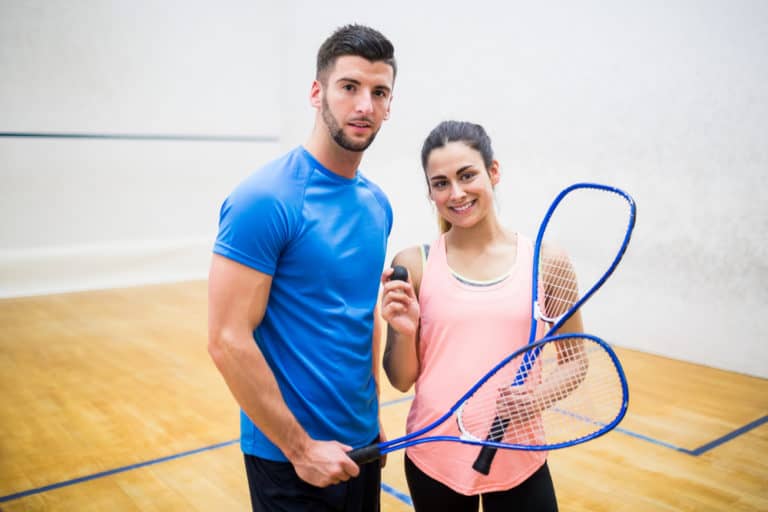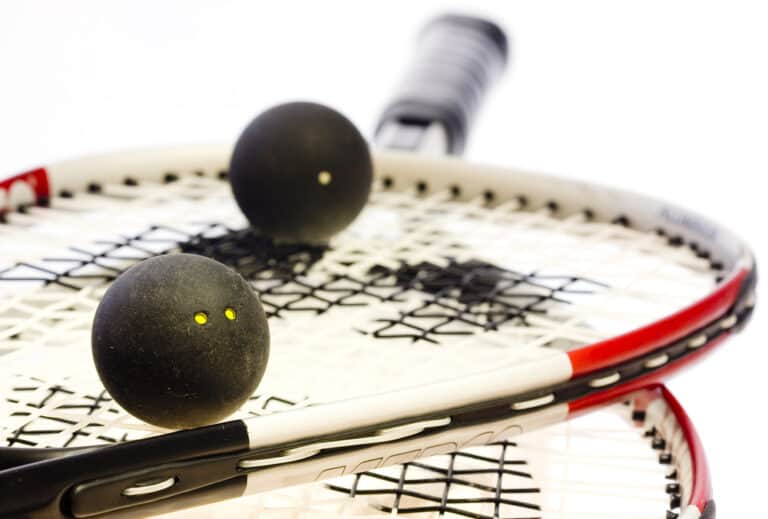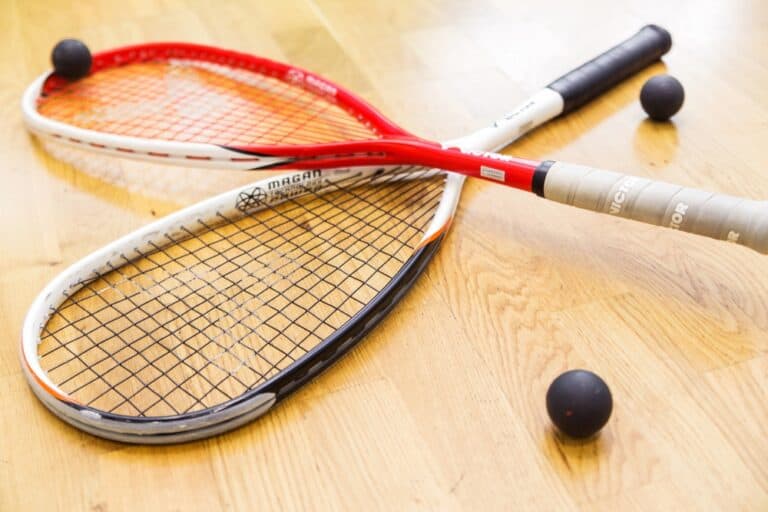How Do You Train For Squash?
Squash is a fun sport that many love, and there are various levels at which one can play. Most players, though, even if they only play on a recreational basis, hope to improve their game. If you are a first-time player who is new to the strange ball, that takes warming up to be able to be played and a racket that is lighter than many others, or a seasoned player, you want to know how to train.
To improve your squash game, you need to engage in on and off-court training, such as squash practice drills, feeding, conditioned games, strength training in the gym, and focus on increasing flexibility. Squash is a high-intensity sport, so always warm up correctly even when training.
You can work on various areas to improve your squash game, and some of these include on-court training, while others can be done at home or in other spaces such as your local gym (which may even offer squash facilities). You want to improve the physical conditioning of your body in a manner tailored to squash, so to learn more about the above, do read on.
Tailoring Your Training For Squash
Various aspects come into this very well-rounded game, including your strength, power, speed, agility, and stability. These are also relevant in many other sports; however, the idea is to tailor your training regime to specifically target the areas needed when you step onto the squash court. And what you want to do is focus your attention on all areas to become better.
For example, when you are putting together your squash training routine, you want to focus on the elements you require for this sport, so if you are doing weight training to aid in strength, you want to increase overall strength. Still, specific movements will benefit you more than others might. For instance, the manner in which the weight is moved could come into play.
Also, the type of training you do should precisely aim to target areas that take the brunt of the force while playing squash to help you insure against injuries. That is why focusing on the ankle, hip, and knee extensions is a good idea, for example, and weight movement exercises such as squats and lunges that help strengthen your legs and encourage the development of stability.
As mentioned, on-court training is essential if you want to improve your game, obviously (and we shall examine this area). Still, off-court training also has its place in aiding you to build a firm foundation and helping you to better your conditioning for when you step back onto the court. Also, training off-court helps break the monotony of spending too much time training on-court.
Squash Practice To Help You Improve Your Game
There are several elements of squash that you can do to ensure that your on-court training is well utilized. The brilliant thing about these training modes is that they will directly correlate to the overall development of your squash game. Below we have included some of the top exercises that you can execute to practice elements directly related to the game.
Feeding
Feeding the ball is a wonderful way to start the session (once you have stretched and warmed up). This exercise is primarily there to aid in fostering your technique. You want to move the ball to exactly where you intend to hit; you also focus on your positioning and your swing.
First, one of the players will hit a drop shot, and the other will stand either on or near the “T”. The second player will then return the ball with a drive. It is best to do this with a partner if possible for this and the other exercises, as it will help you to capitalize on the activity appropriately. Once you have practiced for a fair number of shots, switch over.
This exercise can also be altered to allow players to play volley shots; all in all, you want to improve your shots and your accuracy. The ideal thing to do would be to set markers or points on the court, which will be the designated spot you intend to return the ball to. This routine can benefit several levels of experience, from beginner to pro.
Drills
Various drills can be done, and one of the aims of this is to practice your on-court movement and technique and help you gain awareness of where the other player is on the court. You will also get racket technique training in these exercises, which will carry over into your actual play.
The drills that you run through will not always simulate match play, but that is okay. Some exercises that you encounter will not mirror the type of shots you would ideally play in an actual game or match, but they will help beef up your arsenal. The point of drills is to aid you in learning how to play an array of shots from anywhere on the court, so you are better equipped in the end.
One of the most common drills is continuously driving the ball down one side. This may seem repetitive and unnecessary, but what it does is help you to ensure that you can play the same shot to the same point and have the ball be returned to exactly where you intend for it to land. Various other drills include boast-drive, drive-drive-crosscourt, and boast-crosscourt-drive, among others.
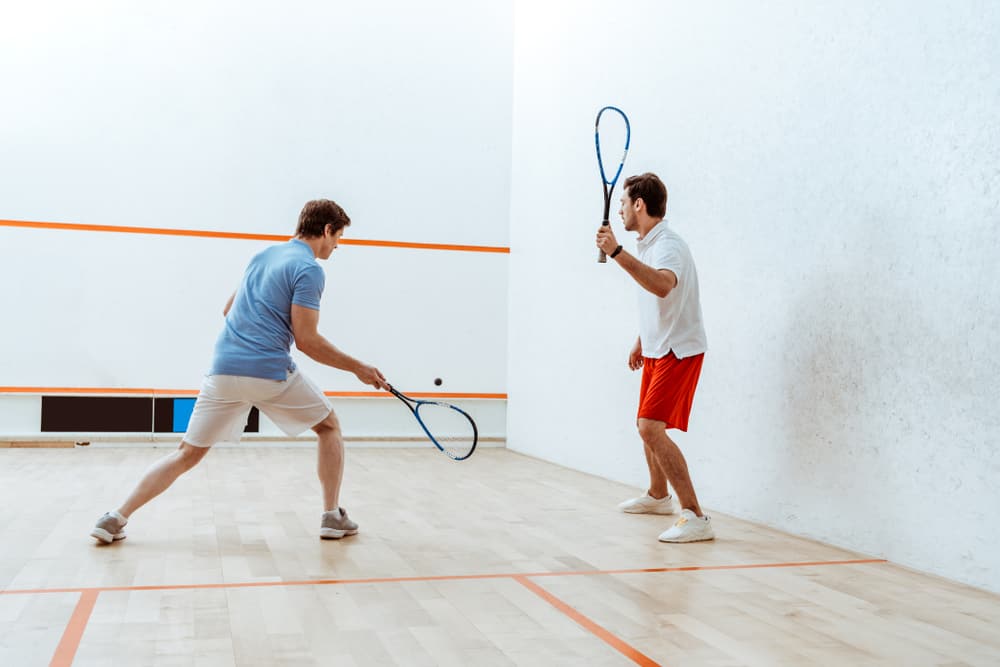
Conditioned Games
Conditioned games will aid your technique, but they will also help tremendously in terms of your tactical approach to playing. In conditioned games, you need to be aware of the limitations you have put on yourself and then how best to play shots to “win” points. Some basic examples include only playing on the back of the court, where all shots must be played there.
Another option is to play where one player must play from the front of the court and the other from the back. You can also opt to play on half the court; this is much like driving the ball in drills, except now you have an array of shots you can play but are limited to the side of the court you may play to. You can even go further and eliminate various quarters of the court.
The basic idea is to practice your strategizing, especially when your options are limited on the court in actual play, focus on footwork and movement, and be mindful of making sure you do not bump into your “opponent” as you practice.
Working On Gaining Explosive Power In Your Legs For Squash
Although the actual playing of the ball is done with your arms, the importance of solid and explosive legs in squash cannot be overstated. You must be able to move swiftly and with explosive power behind you. So take a look at the following exercises that will help you develop this without the packing on unnecessary muscle mass.
Interval Ghosting
Ghosting is not only for power and fitness; it actually contributes to your technical skills, making it the prime exercise to carry out when training for squash. The best type of ghosting is where you do what could be called interval ghosting, where you ghost for 1 minute as quickly as you can but focus on proper movement around the court and realizing its other implications.
Another method of ghosting that will help you explode more from one position to another would be to set cones on the court and have a designated pattern you follow, where you literally run from one cone to another in a predetermined pattern as fast as you can do it. This will also aid in your speed and agility on the court.
Squat Jumps
Next, to aid you in gaining explosive power in your legs is to do squat jumps. It is a simple enough exercise, and all you need to do is squat down as you would for a traditional squat, but then you will exercise as much force as you can and jump as high as possible from that position. One way to ensure consistency is to have a mark or point on the wall you try to touch each time.
Burpees
The third exercise is one that you may well be highly familiar with already and probably do not enjoy, but burpees are a game-changer. There are variations of the burpee, but to get the most out of the exercise, drop down into a push-up position, do said push-up, and then come up and leap as high as possible.
Sprint And Go
Stand in a stationary position and run on the spot, you can jog if you are still working on your fitness levels, but the point is to get to where you are running. Then explode forward in a sprint and only move forward for between 3 to 6 steps. Then repeat the process for a few rounds. This will aid you in the stop-start motion that the sport creates.
Developing Overall Strength For Squash
Strong legs will get you to the ball, but you need to rely on your torso and strong arms and shoulders to aid you in hitting the ball with adequate power. All of these also ensure that your body remains stable throughout the motion and is not thrown off balance by the quick and demanding movements.
Like any sport, particular muscle groups come into play more than others, and although we would recommend training your whole body, there are specific movements that will target key areas for this sport. These exercises will require you to attend your local gym, and if you are new to weight lifting, we highly recommend seeking out the services of a personal trainer to aid you.
The exercises that we recommend you pay special attention to are:
- Leg Press – Works your glutes, quadriceps, and hamstrings
- Weighted Squats – Works your glutes, quadriceps, and hamstrings and aids in overall stability
- Standing Barbell Row – Strengthens back and shoulders
- Barbell Shrugs – Works your trapezius muscles and shoulders
- Bench Press – To aid with building a muscular chest and triceps
- Calf Raises On Machine – Builds stronger calf muscles
- Weighted Russian Twist – Strengthens core and stabilizer muscles
Work On Your Physical Endurance For Squash
If you hope to develop endurance and overall squash fitness, the best exercises will be on-court types such as sprints and ghosting. One ought to consider doing these over things such as road running and jumping on a treadmill at the gym. Although these would carry over onto your on-court play, they do not replicate the sort of movements you need for squash.
There are, however, some alternative exercises that you can do that will aid in your endurance to run around the court and constantly be swinging your racket to hit the ball. Some of these include swimming, cycling, boxing, and climbing on the rowing machine at the gym. We would recommend these because they reduce the amount of exertion placed on your knee and ankle joints.
You can also increase your fitness drastically with these forms of exercise by increasing the intensity at which you perform them. So instead of just swimming laps in the pool or rowing at a moderate pace, you could see how fast you can do those laps or row a certain distance. Additionally, you do not need to utilize “fancy” equipment for your training, such as something like a Peloton bike.
There are plenty of fitness tools on the market, and many of them are purely sold to make money off of people while not really having any advantage over other forms of exercise or types of equipment. One device that is not a gimmick and which is a truly simple and humble piece of equipment is the skipping rope.
As simple as it sounds, the skipping rope is something that even the professionals in the game swear by. And as a squash player, you should have one of these in your arsenal for fitness purposes or even to use when you warm up pre-game. They are easy to carry around and fit into your squash bag without taking up too much space; they are cheap and effective.
Skipping is terrific as it is another one of these exercises where the intensity can be altered as you see fit for your purposes. You can do a low number of skips in a brief period to really get your heart rate going, or if you want to use it to aid in endurance, you can do a couple of hundred skips at a moderate pace.
Improving Your Flexibility For Squash
One thing that may well not come to mind immediately when you think about squash is flexibility, especially if you are new to the sport. However, being flexible for this sport and warming up correctly is paramount to bettering your performance on-court. One of the main reasons, besides ensuring against injuries, is that you will be able to lunge more effectively.
You may well have experienced lunging for the ball, and this often happens when your opponent plays shots that you were not expecting, and you suddenly have to change direction and lunge to reach the ball.
Another benefit of being flexible is that you are far less likely to walk off the court with tight muscles, and any muscle pain that less flexible people may experience will be averted. So be sure to stretch out properly before any form of play. There are various other stretches, but this video will give you a rough guide on how to stretch adequately before playing.
Conclusion
There are plenty of aspects to squash training, and you want to cover them all to become a better player all around. The training consists of on-court and off-court sessions, and you will need to dedicate adequate time to both to truly up your overall strength, fitness, agility, flexibility, and more. We certainly hope you learned a few things, and all the best for bettering your game.
References
- https://blog.controlthet.com/blog/the-4-elements-of-squash-fitness-and-how-to-improve-them
- https://racketstraining.com/2009/06/14/aerobic-training-for-squash-a-case-study/
- https://squashskills.com/blog/-/fitness-training-specificity-for-squash-players-190/
- https://squashmad.com/coaching/how-i-train-and-stay-healthy-by-nick-matthew/
- http://campsquash.com/2022/04/13/preparing-for-squash-camp/
- https://sportscentaur.com/squash-strength-and-conditioning-full-body-program/
- https://www.sweatband.com/blogs/active/five-essential-drills-exercises-to-improve-your-squash-game
- https://www.howicksquash.co.nz/about-squash/fit-for-squash/
- https://www.squashpoint.com/blogs/blog/tips-on-how-to-plan-a-training-session/

